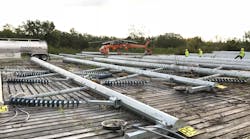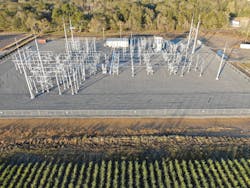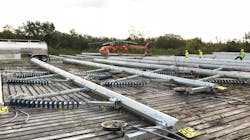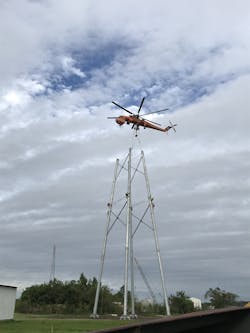The region, which was coined the Acadiana Load Pocket (ALP) because of its location and the transmission constraints, is adjacent to the Gulf of Mexico in south central Louisiana. Because customers of all electric utilities in the ALP could be affected by power restrictions, the utilities worked together to improve reliability for the entire region. “With the completion of this critical transmission upgrade project, Cleco Power’s transmission system is now more resilient and reliable because of good transmission planning, well-executed construction and project management, and close coordination with neighboring electric utilities,” said Robbie LaBorde, chief operations and sustainability officer of Cleco Corporate Holdings, the parent company for Cleco Power.
- Growth in the area which led to increased demand.
- Storm hardening to make the transmission infrastructure more resistant to hurricane-force winds.
- New transmission system planning performance requirements.
Cleco Power spent a total of $312 million on upgrades which included the most modern equipment – higher voltage transmission lines, structures that can withstand hurricane-force winds up to 130 mph, four new substations and other necessary equipment. The upgrades were completed in three phases. The construction work for phase one began in 2010 and the various upgrades continued until the completion of phase three in 2021.
“By completing the upgrades in phases, the company was able to control expenses,” said Chris Thibodeaux, manager of transmission strategy for Cleco Power. “Transmission planning is an ongoing process and building new transmission lines, regardless of the size, takes a considerable amount of lead time due to regulatory laws, financing, planning, design, permitting, siting and land acquisition.” Transmission is the link between generation and distribution systems that ultimately delivers electricity to homes, businesses and critical infrastructure.
“Without transmission, there would be no way to get the electricity from the generating source to the distribution source,” said Terry Whitmore, vice president of transmission services. “This project supports the growth in south Louisiana, and customers in this region will benefit from the additional capacity and storm hardening for years to come.”
Phase One Transmission Upgrades
In phase one, the project addressed the most immediate need which was to expand the flow of electricity in south Louisiana during periods of high demand.
“In this particular area, during the hot summer months when demand for electricity was extremely high, there were constraints on the system,” said Thibodeaux. “Cleco Power had adequate generation in the region to serve customers but needed more transmission capacity due to growth in the area.”
During phase one, Cleco Power partnered with multiple neighboring electric utilities to construct two, 230 kilovolt (kV) lines from its Rork Substation near Eunice, La. to its Segura Substation near New Iberia, La. Cleco Power was responsible for 60 of the 90-miles of line. Construction began in 2010 and was completed in 2012.
The new 230 kV lines were placed near an existing 138 kV line to add more transmission capacity to the area, and both lines can withstand winds speeds up to 120 mph.
“A 230 kV line is energized at 230,000 volts while a 138 kV line is energized at 138,000 volts,” said Dennis Westgate, project management engineer. “A line energized at higher voltage can transmit more power than an equivalent line energized at lower voltage. Having multiple lines with a higher rating also provides redundancy which is one of the most cost-effective ways to increase system reliability.”
Redundancy helps prevent disruptions in electric service in the event of a mechanical problem or natural disaster.
“The additional line is like having another highway to travel on when driving. If something happens, and one highway is closed, you can travel on the other highway to get to your destination,” added Westgate. “Phase one was a notable example of teamwork,” said Walter Halbrook, manager of transmission and distribution engineering and project management. “Phase one would not have been possible without cooperation from neighboring electric utilities.”
Phase Two Transmission Upgrades
In phase two, Cleco Power partnered with another neighboring electric utility to construct a 36-mile 230 kV line from its Terrebonne Substation near Houma, La. to its Bayou Vista Substation in Bayou Vista, La. Cleco Power completed its 12 miles of the line in 2019, connecting its portion from the tie point in Amelia, La. to Bayou Vista Substation.
The neighboring electric utility completed its 24 miles of the line from Terrebonne Substation to the Amelia tie point in 2018. This line can handle wind speeds up to 130 mph.
“All of the new transmission lines are separate and can function independent of the other which means if one has to be taken out of service due to maintenance work, for example, Cleco Power can continue to deliver power to its customers,” said Westgate. “The goal is to responsibly build redundancy into the system to ensure reliable service.”
Cleco Power began routing and designing its portion of the 230 kV line in early 2016 and received the required permits and right-of-way clearing in 2018.
The work in phase two was unique because of the terrain, according to Lance Speer, project construction manager for phase two.
“The line constructed in phase two crosses four major waterways, so the contractors relied extensively on helicopters and specialized equipment,” said Speer. “Included in that terrain are two islands, Avoca Island and Bateman Island, which have no road access.”
To support the line, contractors built 101 new steel transmission structures with many of these structures ranging in height from 80- to 110-feet, which is two-to-three times the size of the average distribution utility pole.
The largest structures are approximately 239-feet tall, the equivalent of a 22-story building, which was the required height for the line to cross the Atchafalaya River and not disrupt activities on the river like shipping.
The line also crosses three other major waterways: Bayou Shaffer, Bayou Boeuf and the Gulf Intracoastal Waterway. Furthermore, the line is designed to help protect the steel structures should debris fly or blow into the line which significantly lessens the potential for structural damage and speeds up the power restoration process.
Phase Three Transmission Upgrades
In the final phase, Cleco Power constructed a 48-mile 230 kV transmission line that can handle wind speeds up to 130 mph from its Bayou Vista Substation in Bayou Vista, La. to Segura Substation near New Iberia, La.
Phase three also included the building of a new 230 kV substation called Caneland at Cleco Power’s Teche Power Station in Baldwin, La. The phase three upgrades began in 2019 and were completed in 2021.
“Contractors constructed a 22-mile line from Caneland to Bayou Vista and a 26-mile line from Caneland to Segura Substation,” said Doug Gates, project construction manager for phase three. “A short 138 kV transmission line connected Caneland to the existing transmission grid at Teche, providing Cleco Power with an alternate power route to meet the bulk power needs of the local communities.”
With all three phases of the project complete, Cleco Power now has multiple interconnected 230 kV transmission lines in the southern portion of its service territory that can withstand hurricane-force winds and meet customers’ growing power needs.
“Together, the new and existing capacity make Cleco Power’s entire transmission system stronger and more reliable,” said Thibodeaux. “The transmission planning group will continue to evaluate grid conditions and produce long-term forecasts of electrical demand to ensure safe delivery of power to customers.”
Fran Phoenix ([email protected]) is a communication strategist III with Cleco Support Group LLC. Fran has more than 20 years of professional experience in communications, public relations, marketing and media relations, including research/writing/editing in two distinct industries – higher education and electric utilities/energy.





